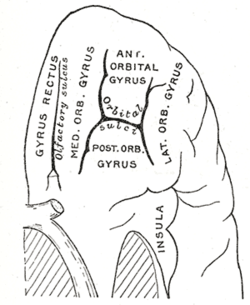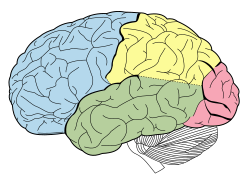| Frontal lobe | |
|---|---|
Principal fissures and lobes of the cerebrum viewed laterally (Frontal lobe is shown in blue.). | |
 | |
| Details | |
| Part of | Cerebrum |
| Artery | Anterior cerebral Middle cerebral |
| Identifiers | |
| Latin | lobus frontalis |
| Acronym(s) | FL |
| MeSH | D005625 |
| NeuroNames | 56 |
| NeuroLex ID | birnlex_928 |
| TA98 | A14.1.09.110 |
| TA2 | 5445 |
| FMA | 61824 |
| Anatomical terms of neuroanatomy | |
The frontal lobe is the largest of the four major lobes of the brain in mammals, and is located at the front of each cerebral hemisphere (in front of the parietal lobe and the temporal lobe). It is parted from the parietal lobe by a groove between tissues called the central sulcus and from the temporal lobe by a deeper groove called the lateral sulcus (Sylvian fissure). The most anterior rounded part of the frontal lobe (though not well-defined) is known as the frontal pole, one of the three poles of the cerebrum.[1]
The frontal lobe is covered by the frontal cortex.[2] The frontal cortex includes the premotor cortex and the primary motor cortex – parts of the motor cortex. The front part of the frontal cortex is covered by the prefrontal cortex. The nonprimary motor cortex is a functionally defined portion of the frontal lobe.
There are four principal gyri in the frontal lobe. The precentral gyrus is directly anterior to the central sulcus, running parallel to it and contains the primary motor cortex, which controls voluntary movements of specific body parts. Three horizontally arranged subsections of the frontal gyrus are the superior frontal gyrus, the middle frontal gyrus, and the inferior frontal gyrus. The inferior frontal gyrus is divided into three parts – the orbital part, the triangular part and the opercular part.[3]
The frontal lobe contains most of the dopaminergic neurons in the cerebral cortex. The dopaminergic pathways are associated with reward, attention, short-term memory tasks, planning, and motivation. Dopamine tends to limit and select sensory information coming from the thalamus to the forebrain.[4]
- ^ Muzio, Bruno Di. "Frontal pole | Radiology Reference Article | Radiopaedia.org". radiopaedia.org.
- ^ João, Rafael Batista; Filgueiras, Raquel Mattos (2018-10-03), Starcevic, Ana; Filipovic, Branislav (eds.), "Frontal Lobe: Functional Neuroanatomy of Its Circuitry and Related Disconnection Syndromes", Prefrontal Cortex, InTech, doi:10.5772/intechopen.79571, ISBN 978-1-78923-903-4, S2CID 149544570, retrieved 2023-06-24
- ^ Carpenter, Malcolm (1985). Core text of neuroanatomy (3rd ed.). Williams & Wilkins. pp. 22–23. ISBN 978-0683014556.
- ^ "Incoming Sensory Information - an overview | ScienceDirect Topics". www.sciencedirect.com. Retrieved 2023-03-31.
